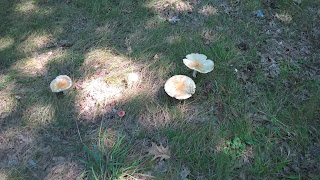 |
| King Boletes or Porcini (Wikimedia Commons). |
I'm a wild-food nut, as anyone who knows me is rather nonplussed to discover. Even worse, I'm a bit of a mushroom fanatic. Every Spring and Fall I start getting a weird urge to walk out in the wet and buggy woods and poke around for hideous toadstools. I can't help it. Everything from Chicken-of-the-Woods to Giant Puffballs are on the menu here. The weirder, the better.
This August blessed us with a tremendous amount of rain, meaning the outdoors are virtually inaccessible due to the preponderance of mosquitoes...but to a shroom-hunter, it means a bonanza. Spring is generally disappointing in Michigan; I've never had much luck morel-hunting, since they never seem to grow where they should, instead appearing in such bizarre spots as my parents' backyard, and then only every fifteen years or so. But Fall mushrooms are much more dependable. The weather is stable, at least in September, being clear and hottish in the daytime, cool at night, and with a low dew-point. Mushrooms like it moist at night when they're growing; but daytime mugginess causes them to rot quickly. Most shroom hunting has to be done at the crack of dawn.
I was on my Sunday afternoon constitutional, walking the River Trail down by a certain park (sorry, gotta keep my shroom patch secret), when I thought I'd check out the picnic area. I'd seen Bolete mushrooms there a couple of years ago, among the oaks - not a massive amount, but some. I got off the trail near and started poking around.
Within five minutes, I'd found a bonanza of Boletes.
 |
| Huzzah for Boletes! |
 |
| The patches kept getting bigger the further I explored... |
Back to the park...whether or not any of these are Porcinis is up for debate, since some species of Boletes are difficult to tell apart; I do know that Cracked-top Boletes were in residence, as well as the Superman Bolete, a reddish cap with bright yellow undersides that stains an alarming shade of blue when cut (it's edible). There were so many of the darn things, I got to be a little choosy: caps that were wormy, soft, or shedding spores I left on the ground, to help continue the species.
 |
| Emeticus. |
 |
| Lactaria species. |
We might as well wade into the prejudices surrounding mushrooms, while we're here. People tend to think all wild mushrooms are a) deadly, or b) hallucinogenic. As usual, over-caution has snowballed into superstition. The vast majority of fungi are simply inedible - like wood, or rocks. A large coterie are useful for various purposes - medicines and the like - with a smaller contingent being edible. A handful are edible and tasty and easy to identify, like morels or Chicken-of-the-Woods. A very, very few are hallucinogenic. And of course, like snakes, a tiny slice of the myriad species are toxic to humans, and of that a very, very few are killers.
 |
| Panther Cap. |
 |
| Destroying Angel. |
 |
| More Panther Caps... |
 |
| And more Panther Caps. |
So yes, mushrooms are weird; but they are also essential to soil development and plant growth. The hyphal network actually transports nutrients from one area to another. Fungi are able to break down just about anything, even oil, and can suck up radioactivity in such places as Chernobyl. Nutritionally speaking, fungi are chock-full of protein and minerals that a growing body needs. By just eating grocery-store mushrooms all the time (which, by the way, are bland as hell), we miss out on a rich panoply of flavors and experiences provided for us by nature.
 |
| A huge Bolete, sunning itself. Blissfully unaware... |
Now, I'm not saying you should just stomp out in the woods and start picking the darn things right left and center; you'll need a good mushroom book for your region, and most important of all a woods-wise individual who's been eating these things for years. And even then, you need to be careful that you don't have an allergic reaction, or eat a raw mushroom, or ingest alcohol with certain species, which will ruin your week. Remember: have fun, be careful.
 |
| Well, ain't that pretty? |
 |
| A flapjack? A catcher's mitt? A huge Pita...? |
Boletes are easy to clean, and smell yeasty, like fresh bread. I cooked up a couple of them in butter and garlic - not the best way, but still decent (Kudos to my roommate Joe for trying them out). I found some good recipes for them online, so I don't ruin the experience by deep-frying to poor things.
Hopefully I'll find more mushrooms popping up as the season wears on. I'm still on the lookout for some good Lion's Mane mushrooms to cook with milk and Dinty Moore beef stew - you end up with a delicate broth, and the mushrooms have a fishlike texture.
At any rate, wish me luck with the Bolete recipes! I'll freeze some for deer season, and throw them in when I do my Venison roast. And to all you shroomers out there: Happy Hunting!
Rick Out.
Comments